Theme Parks & Themed Entertainment
Why For are the ride vehicles for Luigi’s Flying Tires being retooled

Pirate Pete wrote in this weekend to say:
Have you been following what's been going on with the
Luigi's Flying Tires ride at DCA's Cars Land? Why exactly did they remove the
balls from that attraction? Was it a safety issue?
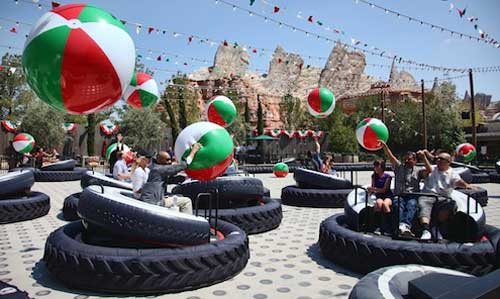
Photo by Paul Hiffmeyer. Copyright Disneyland. All rights reserved
Pirate Pete —
The balls weren't removed from this reimagining of
Disneyland's classic Flying Saucers ride because of safety concerns. But —
rather — because they were slowing down the load / unload procedure for what
was already a very slow loading / low capacity attraction. And given the large number
of Guest complaints that this newly-retooled theme park was getting from people
who've literally spent hours in line on to then have a two minute-long
experience aboard Luigi's Flying Tires … Well, the Imagineers knew that they
had to do something.
Mind you, what's kind of ironic about this is that the Spring
2012 decision to add all of those beach balls to Luigi's — give this new DCA
attraction a colorful, kinetic element (which was then supposed to distract Guests
from noticing that the Flying Tires don't exactly zoom around. That this
supposedly thrilling, interactive ride is really more of a mild, slow-moving
experience) — came very late in the game. With the Imagineers reportedly drawing
their inspiration from a piece of archival footage that they'd discovered of Disneyland's original
Flying Saucers attraction which showed this Tomorrowland attraction filled with
colorful balloons. Which were then knocked into the air as Guests deliberately
drove their Flying Saucers through those piles of balloons that were scattered
around the floor.
Of course, what the Imagineers didn't initially realize was
that this archival footage of Disneyland's Flying Saucers attraction had come
from a 1960s era episode of "Walt Disney's Wonderful World of Color."
And because the film crew which had been tasked with filming this then-still-new
Tomorrowland attraction had decided that the Saucers were (all of their own) a
little too slow-moving & bland-looking to give them the sort of colorful,
dramatic footage that they really needed for this TV show … Well, that's when
the decision was made to pour hundreds of balloons to the air cushion pen that
Disneyland's Flying Saucers floated around in.
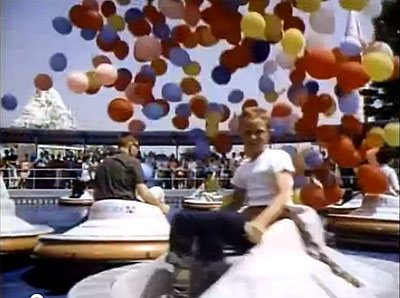
Copyright Disney Enterprises, Inc. All rights reserved
So as you can see, even back in the early 1960s, Disney
insiders were looking for ways to make this floating-on-air attraction appear to be far
more exciting & colorful than it actually was.
Anyway … Now that
all of those beach balls are gone, what are the Imagineers going to do to try
and improve the ride experience that Guests have once they climb aboard one of
Luigi's Flying Tires? Given all of this
attraction's safety protocols (i.e. each vehicle must be individually visually inspected
to make sure that all occupants are restrained by a safety belt before the Cast
Members are then allowed to fire the underground engines which then provide the
cushion of air that these oversized tires ride on), it's always going to be a
very-slow-to-load attraction. So what WDI is now concentrating on is trying to
make Luigi's Flying Tires an overall far more satisfying ride experience.
"And how exactly are they going to pull that off?,"
you ask. Well, you have to understand that — during the initial test phase of
Luigi's Flying Tires — each of these Flying Saucer-like ride vehicle was equipped
with a joy stick-type control mechanism.
Which — depending on what direction you pushed this joy stick in — sent your
Flying Tire floating off towards that side of the attraction.
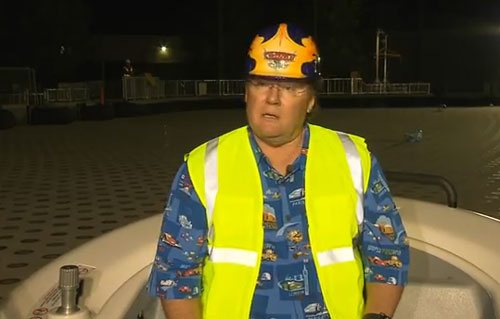
John Lasseter in an early promotional video for Luigi's Flying Saucers. Please note
— directly to the left of Lasseter — the original joy stick / ride control mechanism for
this DCA attraction. Copyright Disney Enterprises, Inc. All rights reserved
The only problem was the Disneyland Resort Cast Members who
were recruited to take part in the early, early onsite tests for Luigi's Flying
Tires found this joy stick-like ride control system confusing / difficult to
use. And the Imagineers figured that — if Cast Members (some of whom literally
spend 8 hours a day dealing with the balky ride control systems on various DCA
& Disneyland attractions) couldn't figure out how the ride control system
on Luigi's Flying Tires actually operated … Well, what chance did members of
the general public have?
So during the test-and-adjust phase for this new Cars Land
attraction, the Imagineers actually removed these joy sticks from all of the
control consoles on the Luigi's Flying Tires ride vehicles. Though — that said
— there's still 20 pounds of hardware hidden deep down inside of each of these Tires which was
supposed to respond every time you pushed that joy stick.
The Imagineers are hoping that — if they remove the rest of
that joy stick hardware (and thereby decrease the weight of each of these ride
vehicles by 20 pounds) — that single change will make Luigi's Flying Tires that
much more satisfying an attraction. That — because all of these ride vehicles will
soon be lighter — they'll then be able to zoom around the air cushioned floor of this
Cars Land attraction that much quicker. Which will make for a far more
satisfying Guest experience.

Tony Shaloub at Uptempo Studios earlier this year recording the
audio components for Luigi's Flying Tires. Copyright Uptempo
That's WDI's hope, anyway. But let's remember that these are
the same folks who brought Tony Shaloub back in at the last minute to record
all of these "Cars" – inspired Italian parody songs. With the hope
that this new musical element would then add an additional layer of fun to this
DCA attraction.
But the hard fact of the matter is — no matter how many
beach balls WDI adds and/or Italian-inspired comical songs they play — there's
just no getting around the fact that Luigi's Flying Tires (just like the
classic Disneyland ride which inspired it) is always going to be a slow loading
/ low capacity attraction with a short ride time which is also short on thrills.
Which means that DCA's Guest Relations staffers are pretty much guaranteed to
be getting a steady stream of complaints about Luigi's Flying Tires from people
who feel that they spent far too much time in line to then experience such an
underwhelming attraction.
Mind you, there used to be people who worked at Walt Disney
Imagineering who knew things like this. Veteran Imagineers who had actually
worked on the original Disneyland version of Flying Saucers and who could speak at
great length about how difficult it was to operate & properly maintain this
particular Tomorrowland attraction. Which is one of the main reasons that the
Flying Saucers only operated at
Disneyland from August of 1961 through August of 1966 before Walt
himself pulled the plug on this problematic ride.

John Hench and Walt Disney onsite as the demolition
of Disneyland's original Tomorrowland gets underway
in September of 1966. Copyright Disney Enterprises,
Inc. All rights reserved
You get that, right? That Walt Disney himself — when he was
putting together his final plans for 1967's New Tomorrowland — deliberately
decided not to include a revamped version of the Flying Saucers as part of his
Disneyland redo because — even back then — this ride for slow to load,
difficult to operate and didn't deliver all that great a Guest experience.
Which perhaps explains what I witnessed on the night of June
13th of this year. Which was the night that the Disneyland Resort's PR staff held their big
Cars Land Media Party.
Let me take a moment to properly set the stage here: I'm in
line for Luigi's Flying Tires. And as I'm making my way through this
attraction's queue, I realize that there's something very familiar about the older gentleman who's
directly ahead of me in line. Eventually I realize that this guy is Disney
Legend Ron Dominguez.
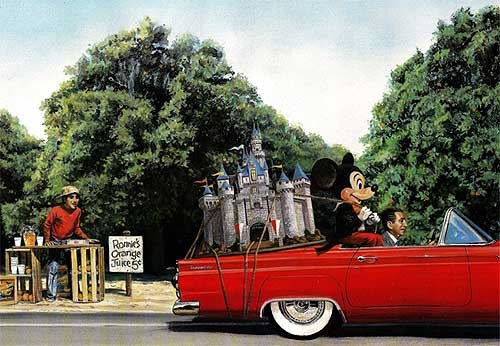
This obviously isn't how it actually went down. But — rather — its Charles Boyer's fantasy
of how young Ron Dominguez learned about what Walt Disney had in the works for the
orange groves that his family opened in Anaheim. Boyer painted this image for the
cover of the Disneyland Line (i.e. that theme park's employee newsletter) which
was published on July 17, 1980 for the 25th anniversary of this theme park.
Walt Disney Company. Copyright Disney Enterprises, Inc.
All rights reserved
For those of you who don't know: Dominguez literally is a
native Disneylander. His family actually owned 10 acres of the land that Walt
Disney had to purchase in Anaheim in order to build the Happiest Place on
Earth. And to hear Ron tell the story, the Dominguez family manse (which had
been built in Orange County back in the 1880s) was originally located in New
Orleans Square, somewhere between Pirates of the Caribbean and Cafe Orleans.
Anyway, given that Ron was looking for a summer job back in 1955, four days
before Disneyland opened to the public, Dominguez took a position as a ticket
taker at this theme park's front. And Ron then stayed on at the Disneyland
Resort for the next 39 years, eventually rising through the ranks to become
Executive Vice President of Walt Disney Attractions for the entire West Coast.
So you get what I'm saying here, right? If there's ever a
person who knew his early Disneyland history, it's Ron Dominguez. By that I mean,
this guy lived it firsthand.
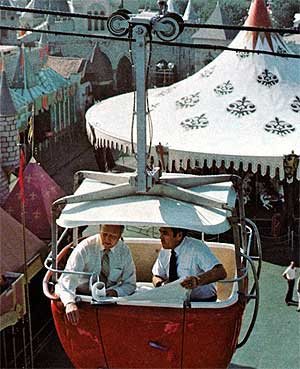
Ron Dominguez (on the right, wearing the dark tie)
rides the Tomorrowland Skyway with his then-boss
Dick Nunis in the Fall of 1980 as they discuss the
upcoming reimagining of Disneyland's Fantasyland
section. Copyright Disney Enterprises, Inc.
All rights reserved
Which is why — when Ron finally made it to the part of the Luigi's
Flying Tires queue where you can actually look out and see the ride vehicles — I just had to
laugh. Dominguez took one look at those Flying Saucers-like ride vehicles and
then loudly said "Oh, God. Not these things again." And with that,
Ron turned around and — after saying "Come on. We're getting out of
here" to the pair of women he was traveling with that night —
Dominguez quickly exited the queue.
Okay. I know. That's the reaction of a single individual.
But you gotta remember that — back in 1962 — Ron Dominguez was actually named
supervisor of Tomorrowland. So if
there's ever been a person who's intimately aware of how difficult Disneyland's
Flying Saucer attraction was to operate, it's this guy. So the fact that Ron
would immediately turn tail and run at the mere sight of Luigi's Flying Tires
… Well, that doesn't exactly bode well for the future of this Cars Land
attraction.
I'm told that — after all of the ride vehicles for Luigi's
Flying Tires have been lightened up (which should be completed sometime later
this month) — DCA's going to commission yet another Guest survey to see if the
lightened-up versions of these tires are delivering a better Guest experience.
And if not … Well, it'll be interesting to see what the Imagineers do next
here. Whether they do what WED did back in the mid-1960s, replace this Flying
Saucers / Flying Tires ride with something that's easier to operate / more of a
Guest satisfier. Maybe take that nearby expansion pad (which has been set aside
for the DCA equivalent of DHS's popular Sci-Fi Dine-In Theater restaurant) and
combine it with the property that Luigi's Flying Tires currently occupies to
create a Cars-themed attraction which has a far higher theoretical hourly ride
capacity as well as being a better overall Guest experience.
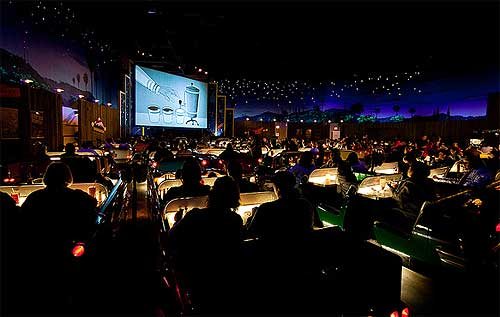
The interior of the Sci-Fi Dine-In Theater Restaurant at Disney's Hollywood Studios.
Copyright Disney Enterprises, Inc. All rights reserved
Does that answer your question, Pirate Pete? I hope so.
And just in case you're wondering, folks: Yeah, we're doing
a little experimenting with JHM's content. Seeing how this site's readers might
respond to Why For being a daily — rather than weekly — column. So if you've
got any Disney or theme park-related questions that you'd like to see answered
as part of this week's experiment, please send them along to
whyfor@jimhillmedia.com.
Your thoughts?
Television & Shows
The Untold Story of Super Soap Weekend at Disney-MGM Studios: How Daytime TV Took Over the Parks

A long time ago in a galaxy that … Well, to be honest, wasn’t all that far away. This was down in Florida after all. But if you traveled to the WDW Resort, you could then experience “Star Wars Weekends.” Which ran seasonally at Disney’s Hollywood Studios Disney World from 1997 to 2015.
Mind you, what most folks don’t remember is the annual event that effectively plowed the road for “Star Wars Weekends.” Which was “Super Soap Weekend.” That seasonal offering — which allowed ABC soap fans to get up-close with their favorite performers from “All My Children,” “General Hospital,” “One Life to Live” and “Port Charles” — debuted at that same theme park the year previous (1996).
So how did this weekend-long celebration of daytime drama (which drew tens of thousands of people to Orlando every Fall for 15 years straight) come to be?
Michael Eisner’s Daytime TV Origins and a Theme Park Vision
Super Soap Weekend was the brainchild of then-Disney CEO Michael Eisner. His career in media began with short stints at NBC and CBS, but it truly took off in 1964 when he joined ABC as the assistant to Leonard Goldberg, who was the network’s national programming director at the time.
Eisner quickly advanced through the ranks. By 1971, he had become Vice President of Daytime Programming at ABC. That meant he was on the scene when One Life to Live joined the lineup in July 1968 and when All My Children made its debut in January 1970. Even after being promoted to Senior Vice President of Prime Time Programming in 1976, Eisner stayed close to the daytime division and often recruited standout soap talent for ABC’s primetime shows.
Fast forward nearly two decades to July 31, 1995. The Walt Disney Company announced that it would acquire ABC/Cap Cities in a $19 billion deal. Although the acquisition wasn’t finalized until February 1996, Eisner was already thinking ahead. He wanted to use the stars of All My Children, One Life to Live, and General Hospital to draw people to Disney’s theme parks.
He had seen how individual soap stars were drawing huge mall crowds across America since the late 1970s. Now he wanted to bring dozens of them together for something much bigger.
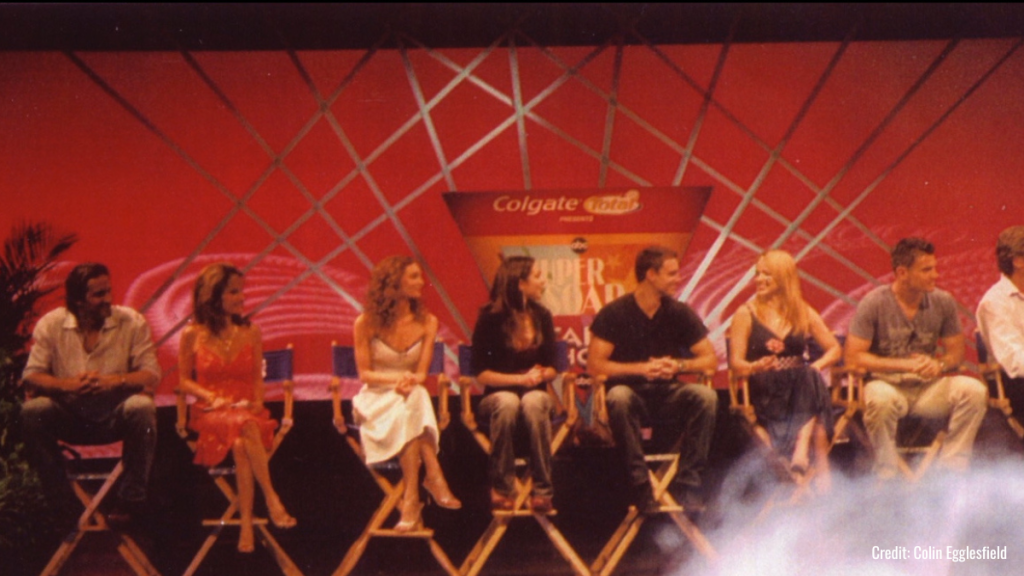
Super Soap Weekend Takes Over Disney-MGM Studios
The very first Super Soap Weekend was announced in June 1996, just a few months after the ABC deal closed. The event was scheduled for October 19 and 20 at Disney-MGM Studios and was a massive success.
The weekend featured panel discussions, autograph sessions, and photo opportunities with the stars of ABC’s daytime dramas. Thousands of fans packed the park for the chance to meet their favorite actors. Due to the overwhelming response, the event became an annual tradition and was eventually moved to Veterans Day weekend each November to better accommodate attendees.
Longtime fans like Nancy Stadler, her mom Mary, and their close friend Angela Ragno returned year after year, making the event a personal tradition and building lifelong memories.




West Coast Events and the ABC Soap Opera Bistro
Disney even tried to recreate the event out west. Two Super Soap Weekends were held at Disneyland Resort, one in April 2002 and another in June 2003.
At Disney’s California Adventure, Eisner also introduced the ABC Soap Opera Bistro, a themed dining experience that opened in February 2001. Guests could dine inside recreated sets from shows like General Hospital and All My Children, including Kelly’s Diner and the Chandler Mansion. The Bistro closed in November 2002, but for fans, it offered a rare opportunity to step into the world of their favorite soaps.
SOAPnet, Port Charles, and the Expansion of Daytime TV at Disney
Eisner’s enthusiasm for soaps extended beyond the parks. In January 2000, he launched SOAPnet, a cable channel dedicated to prime time replays of ABC’s daytime dramas.
During his time at Disney, General Hospital also received a spin-off series titled Port Charles, which aired from June 1997 to October 2003. The show leaned into supernatural plotlines and was another example of Eisner’s commitment to evolving and expanding the soap genre.
The Final Curtain for Super Soap Weekend
In September 2005, Eisner stepped down after 21 years as head of The Walt Disney Company. Bob Iger, who had previously served as President of ABC and Chief Operating Officer of ABC/Cap Cities, took over as CEO. While Iger had deep ABC credentials, he didn’t share Eisner’s passion for daytime television.
In the fall of 2008, Disney hosted the final Super Soap Weekend at what was then still called Disney-MGM Studios. That same year, the park was rebranded as Disney’s Hollywood Studios, and Disney began shifting away from television-focused experiences.
Within the next five years, the rest of Eisner’s soap legacy faded. One Life to Live was canceled in January 2012. SOAPnet was rebranded as Disney Junior in February 2013. Later that year, All My Children ended its 41-year run on ABC.
Only General Hospital remains on the network today, the last standing soap from the golden age of ABC Daytime.
A New Chapter for Daytime TV and Super Soap Fans
The soap genre may have faded from its former glory, but it’s not gone. On February 24, 2025, CBS premiered a brand-new daytime drama called Beyond the Gates, marking the first new soap launch in years.
Meanwhile, All My Children alum Kelly Ripa has been actively working on a revival. In September 2024, she mentioned a holiday-themed movie set in Pine Valley that would bring back many original cast members. The project was in development for Lifetime, though its current status is unclear.
And what about Super Soap? Fans like Nancy and Angela still hope Disney will bring it back. Even if it only featured the cast of General Hospital, it would be a welcome return for longtime viewers who miss that one weekend a year where the magic of Disney collided with the drama of daytime TV.
If you want to hear firsthand what it was like to be part of Super Soap Weekend, be sure to listen to our I Want That Too podcast interview with actor Colin Egglesfield. He shares behind-the-scenes memories from his days as Josh Madden on All My Children and what it meant to be part of one of the most unique fan events in Disney park history.
History
The Super Bowl & Disney: The Untold Story Behind ‘I’m Going to Disneyland!’

One of the highlights of the Super Bowl isn’t just the game itself—it’s the moment when the winning quarterback turns to the camera and exclaims, “I’m going to Disney World!” This now-iconic phrase has been a staple of post-game celebrations for decades. But where did this tradition begin? Surprisingly, it didn’t originate in a stadium but at a dinner table in 1987, in a conversation involving Michael Eisner, George Lucas, and aviation pioneers Dick Rutan and Jeana Yeager.

The Unlikely Beginning of a Marketing Sensation
To understand the origins of this campaign, we have to go back to December 1986, when the Rutan Voyager became the first aircraft to fly around the world without stopping or refueling. Pilots Dick Rutan and Jeana Yeager completed the nine-day journey on December 23, 1986, flying over 26,000 miles before landing at Edwards Air Force Base. Their historic achievement earned them national recognition, and just days later, President Ronald Reagan awarded them the Presidential Citizen Medal at the White House.
Meanwhile, Disney was gearing up for the grand opening of Star Tours at Disneyland, set for January 12, 1987. Following its usual playbook of associating major theme park attractions with real-world pioneers, Disney’s PR team invited astronauts Gordon Cooper and Deke Slayton to the launch event. But in a twist, they also invited Rutan and Yeager, who were still making headlines.

A Dinner Conversation That Changed Advertising Forever
After the Star Tours opening ceremony, a private dinner was held with Disney CEO Michael Eisner, George Lucas, and Eisner’s wife, Jane. During the meal, Eisner asked Rutan and Yeager, “You just made history. You traveled non-stop around the planet on a plane without ever refueling. How are you ever going to top that, career-wise? What are you two gonna do next?”
Without hesitation, Jeana Yeager replied, “Well, after being cramped inside that tiny plane for nine days, I’m just glad to be anywhere else. And even though you folks were nice enough to fly us here, invite us to your party… Well, as soon as we finish eating, I’m gonna go over to the Park and ride some rides. I’m going to Disneyland.”
Jane Eisner immediately recognized the power of Yeager’s statement. On the car ride home, she turned to Michael and said, “That’s a great slogan. I think you should use that to promote the theme parks.” Like many husbands, Michael initially dismissed the idea, but Jane persisted. Eventually, Eisner relented and pitched it to his team.
The Super Bowl Connection
With Super Bowl XXI just around the corner, Disney’s PR team saw an opportunity. The game was set for January 25, 1987, at the Rose Bowl in Pasadena—just miles from Disney Studios. What if they convinced the winning quarterback to say, “I’m going to Disneyland” live on-air?
Disney quickly struck a deal with both quarterbacks—Phil Simms of the New York Giants and John Elway of the Denver Broncos—offering each $75,000 to deliver the line if their team won. Simms led the Giants to victory, making history as the first athlete to say, “I’m going to Disney World!” on national television.
A Marketing Triumph
That year’s Super Bowl had the second-highest viewership in television history, with 87 million people watching Simms say the famous line. The next day, Disney turned the clip into a national commercial, cementing the phrase as a marketing goldmine.
Since then, “I’m going to Disneyland” (or Disney World, depending on the commercial) has been a staple of championship celebrations, spanning the NFL, NBA, and even the Olympics. What started as a casual remark at dinner became one of the most successful advertising campaigns in history.
A Lasting Legacy
Jane Eisner’s keen instinct and Disney’s ability to act quickly on a great idea created a tradition that continues to captivate audiences. The “I’m going to Disneyland” campaign remains a testament to the power of spontaneous inspiration and smart marketing, proving that sometimes, the best ideas come from the most unexpected places.
To learn more about Disney’s ties to the world of sports, check out I Want That Too: A Disney History and Consumer Product Podcast.
Television & Shows
How the Creators of South Park Tricked A-List Celebrities to Roast Universal – “Your Studio & You”
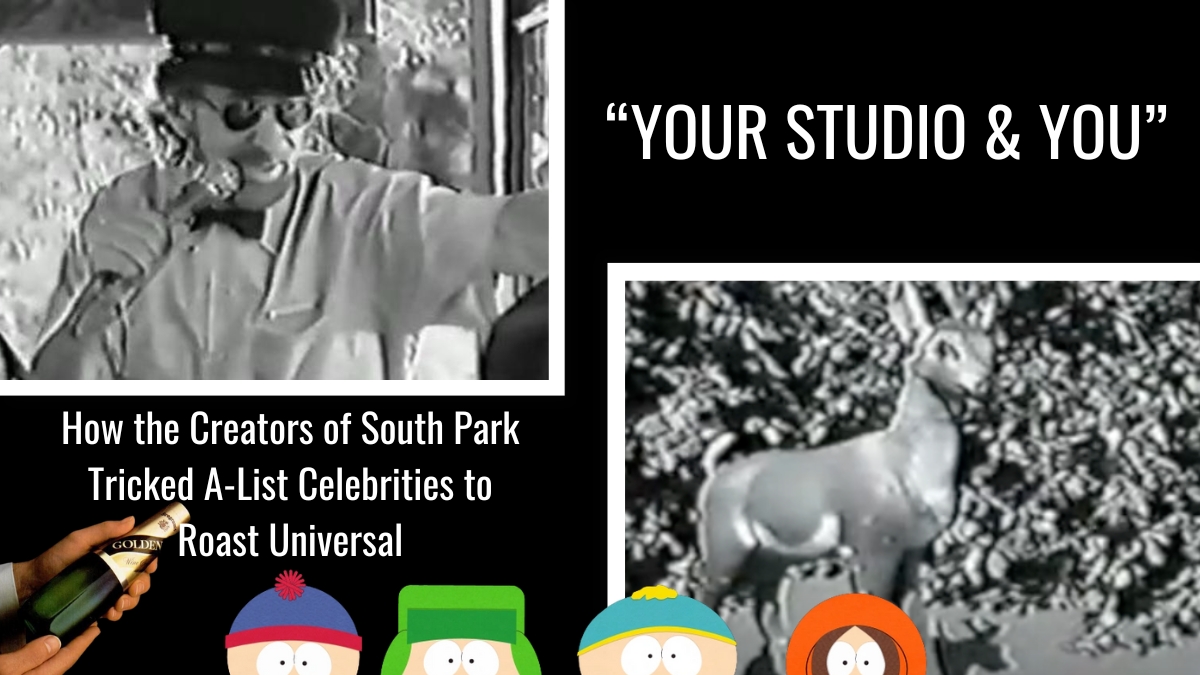
Universal Studios has a rich and storied history, but few moments are as peculiar—and as hilariously cutting—as the creation of Your Studio & You. This 14-minute parody film, commissioned in 1995 to celebrate Universal’s new ownership under Seagram’s, brings together an all-star cast, biting humor, and the unmistakable comedic fingerprints of Matt Stone and Trey Parker.
Long before South Park debuted on Comedy Central in 1997, Stone and Parker were already carving out a reputation for their irreverent style, and Your Studio & You perfectly encapsulates their knack for turning even the most corporate project into something delightfully subversive.
Matt Stone & Trey Parker Before South Park
Stone & Parker were already known out in Hollywood as funny guys. Thanks largely to “The Spirit of Christmas,” which was this video greeting card that they’d crafted for a Fox executive – who then distributed this infamously funny thing (which had Our Lord Jesus Christ & Santa Claus literally duking it out for the holiday affections of Cartman, Kenny, Stan & Kyle) to friends & family.
This was the early 1990s. No internet. Each copy of “The Spirit of Christmas” was made on VHS tape and then mailed. Went viral the old-fashioned way. It’s rumored that George Clooney made over 300 copies of “The Spirit of Christmas” and passed these VHS taps along to friends and family.
Things didn’t move as fast as they do today. “The Spirit of Christmas” still became a sensation out West.
Zucker Brothers
Matt & Trey also had other supporters in the entertainment industry. Among them David Zucker, who was one of the members of ZAZ (i.e., Zucker Abrahams Zucker), the talented trio that made “Airplane!” in 1980, “Top Secret!” in 1984 and the three “Naked Gun” movies.
- The original “Naked Gun” in 1988
- “Naked Gun 2 & 1/2 : The Smell of Fear” in 1991
- and “Naked Gun 33 & a 1/3: The Final Insult” in 1994
All five of these parody films had been made for Paramount Pictures. But in the Late Winter / Early Spring of 1995, Universal had persuaded the Zucker Brothers to come over and set up shop in a bungalow on their lower lot. With the hope that – at some point further on down the line – David & his brother Jerry would start making funny films for Universal.
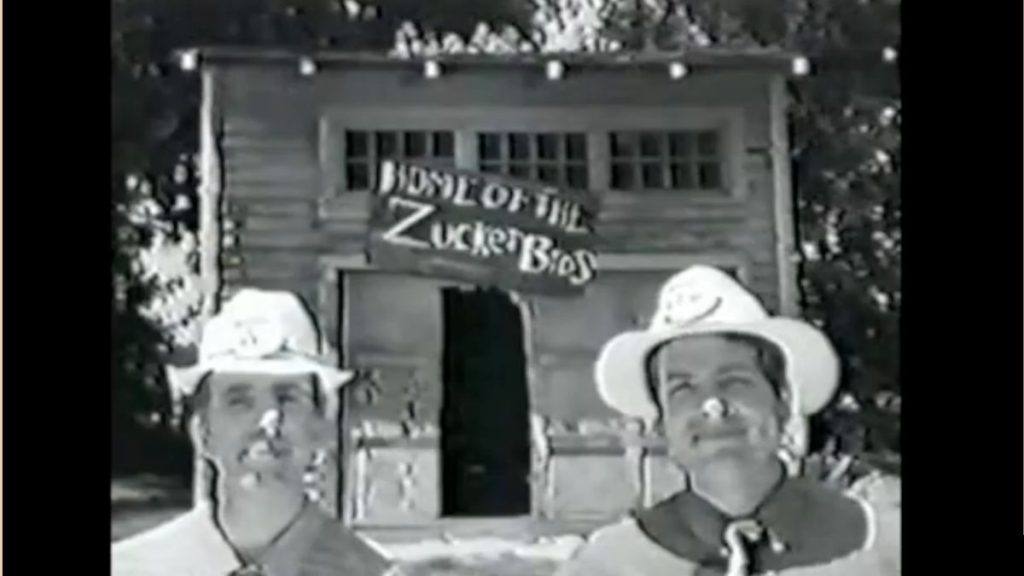
And it’s during this same window of time (We’re now talking April of 1995) that news breaks that Seagrams (Yep, the adult beverage company. Who – at the time – was making an absolute fortune on the sales of wine coolers) was about to buy a majority stake in MCAUniversal. We’re talking control of 80% of that company’s stock. Which would effectively make Seagrams the new owners of Universal Studios.
Edgar Bronfman
And Edgar Bronfman – the owner of Seagrams – knew that Universal had had a tough time with its previous owners – which had been the Matsushita Electric Industrial Co. of Japan. Matsushita had bought MCA back in November of 1990 for $7.5 billion but had never really understood the entertainment industry.
This is why – after repeatedly butting heads with Lew Wasserman & Sidney Sheinberg (i.e., the heads of Universal Studios & the Universal theme park respectively) when it came to creative control of this company – Matsushita decided to wash it hands of the entire enterprise. Agreeing to sell their holdings in MCA to Seagrams for $5.7 billion (effectively taking a nearly $2 billion loss on this investment).
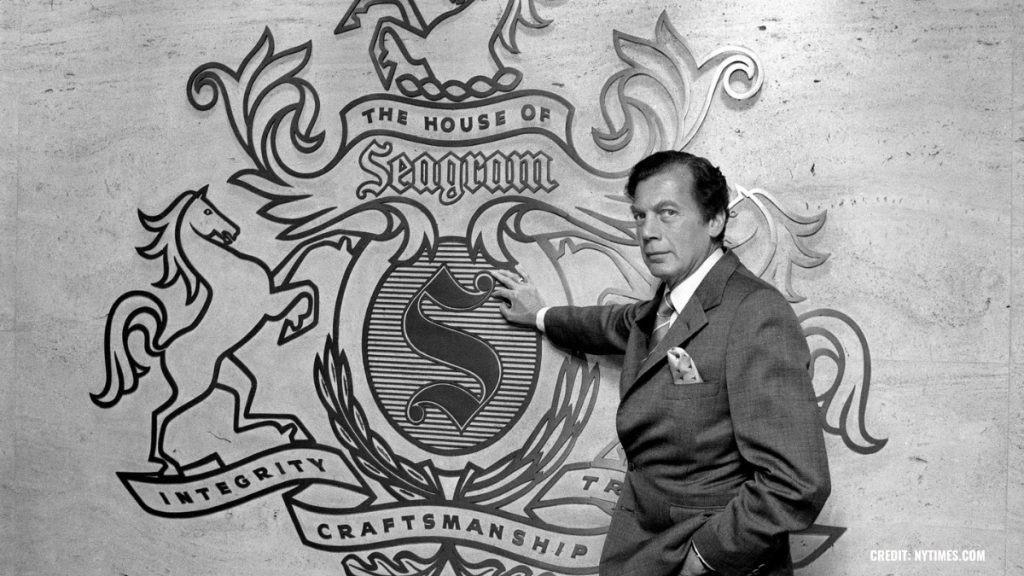
And Bronfman … He knew that some bad feeling had developed between Hollywood’s creative community and the Japanese owners of Universal. The thinking was that executives at Matsushita Electric had just not gotten what it took to make movies & TV shows.
And Edgar? Right from the get-go, he wanted to show that Seagrams was NOT going to be Matsushita Electric Redux. Bronfman was looking for a way to send a clear message to Hollywood’s creative community that Universal’s new owners got it. That they were willing to work with Hollywood to make the best possible movies & TV shows at Universal.
And how did Edgar decide to get this message across? By making a funny movie.
Zucker Commissions Trey Parker for “Your Studio & You”
Mind you, Bronfman himself didn’t make this film. The owner of Seagrams reached out to David Zucker. Who – after initially agreeing to produce this introduction-to-Universal film – then farmed out the production of the actual project to Trey Parker. Who – just two days before shooting was supposed to star on the Universal Lot – persuaded Matt Stone to come help him on this project.
Which brings us to “Your Studio and You.” Which is a parody of an educational film from the 1950s, right down to being shot in black & white and featuring a very generic soundtrack.
Now what’s amazing about watching “Your Studio and You” today is that this 14-minute-long film features some of the biggest names working in Hollywood back in the mid-1990s. We’re talking about people like recent Golden Globe winner Demi Moore, Sylvester Stallone, Michael J. Fox and Angela Lansbury. Not to mention two of the most powerful men in all of Hollywood, Steven Spielberg & Jeffrey Katzenberg.
And what’s especially interesting about watch “Your Studio and You” is that – as you watch these performers go through their paces in this motion pictures (which – most of the time – involves doing some innocuous task while holding a Seagram’s wine cooler) – you often get the feeling that this star is not in on the gag.
So how did Matt & Trey get away with this? Simple. There was never actually a script for “Your Studio and You.”
Filming “Your Studio & You” at Universal Studios Hollywood
Mind you, David Zucker would always insist that there was. Especially when he’d phone up celebrities on the Universal Lot and say “Hey, I’m sending over a couple of college kids later today. They’re working with me on a new parody film. It’s something that we’re doing for the new owners of Universal. I need just a half hour of your time. We’re shooting something special for the party we’ll be holding when the Seagrams people first arrive at the Studio. Absolutely. You’ll definitely get an invite to that party. So can I count on you to help these kids out? Beautiful. They’ll be over there later this morning.”
And then Matt & Trey would show up and say “… Dang, Miss Lansbury. We’re sorry. We must have left our copy of the ‘Your Studio and You’ script back in our office. Which is clear on the other side of the Lot. So – rather than waste your time – why don’t we do this instead? Follow us over to the Psycho House. Where we’re then going to get footage of you painting the front porch on Mother Bates’ house while you say ‘Gosh, with all of the wonderful improvements going on around here, everyone is going to want to work at Universal.’ Oh, and can we also get you to wear this button on the front of your blazer which reads ‘Universal is A-OK’ ? “

And over & over again, the biggest names who were working for Universal at that time took part in the production of “Your Studio & You” because A) David Zucker vouched for Matt Stone & Trey Parker and B) this was something that was being made for the new owners of Universal. And it’s just natural to want to get in good with the new boss.
Steven Spielberg, Jeffery Katzenberg, and Jaws
But no one at Universal anticipated that “Your Studio & You” would wind up being as sharp edged as the finished product turned out to be. I mean, it’s one thing to bite the hand that feeds you. But “Your Studio & You” ? It doesn’t just bite the hand. It takes the hand off at the wrist.
It’s a brutally funny film. With one of the meanest moments reserved for Steven Spielberg, who plays a driver on the Universal Studio Tour who’s trying to persuade a tram full of bored tourists (one of whom is played by Jeffery Katzenberg) that the “Shark Attack” scene down by Jaws Lagoon is actually exciting.
Spielberg actually says lines like “ … Whoa, whoa. What is going on here? Ladies and gentlemen, this never happens. Look out! It’s a shark! Whoa, that is one big scary shark.”

Mind you, as footage of this mechanical shark repeatedly coming up out of the water is shown, “Your Studio & You” ‘s off-screen narrator (who is voiced by Trey Parker says):
“But what about tomorrow? If we don’t keep in step with the times, things that were once neat and thrilling can become old and stupid.”
“Your Studio & You” Reception
This film was supposed to be shown only once at the welcoming party for Seagrams executive on the Universal Lot. And I’m told that – when Edgar Bronfman saw the finished product at that party – he reportedly turned to David Zucker and said “ … That’s a little more mean-spirited that I think it needed to be.”
And with that, “Your Studio & You” was supposed to go back into the Universal vault, never to be seen again. But when “South Park” debuted on Comedy Central in August of 1997 and then became a sensation for its biting humor, there was suddenly a lot of interest in what else Matt & Trey had done. Which is why copies of “The Spirit of Christmas” began to circulate. And – over time – copies of “Your Studio & You” began to bubble up.
Which – as Stone & Parker have repeatedly pointed out – was just not supposed to happen. Largely because none of the celebrities who appeared in “Your Studio & You” had never signed releases for Universal’s legal department. Because – again – this was for a movie that was only going to be shown once at a private function on the Universal Lot.
Matt mentioned (as part of a career retrospective at the Paley Center in LA back in 2000) that “ … they wouldn’t even let us keep a copy of the finished film.”
It’s a funny but brutal movie. And worth taking a look at today especially if you’re a theme park history buff because it shows Universal Studios Hollywood’s “Jurassic Park: The Ride” still under construction on the Lower Lot. That attraction would finally open to the public in June of 1996.
“Your Studio & You” became a lot easier to see after Seagrams sold off its share of Universal to Vivendi in 2000. Copies began propagating online after that. Though Universal Legal will periodically make an effort to get the latest copy of “Your Studio & You” taken off the Internet because – again – none of the performers who appear on camera ever signed the proper releases and/or were paid for their efforts.
That said, if you’re up for a mean-spirited laugh, “Your Studio & You” is well worth 14 minutes of your time. That said, once you watch this thing, be warned:
- You’re immediately going to be thirsty for a Seagram’s wine cooler
- And you’re going to have a sudden desire to go out & buy a porcelain deer.
-

 Theme Parks & Themed Entertainment7 months ago
Theme Parks & Themed Entertainment7 months agoDisney’s Forgotten Halloween Event: The Original Little Monsters on Main Street
-

 Theme Parks & Themed Entertainment8 months ago
Theme Parks & Themed Entertainment8 months agoThe Story of Mickey’s Not-So-Scary Halloween Party: From One Night to a Halloween Family Tradition
-

 Film & Movies8 months ago
Film & Movies8 months agoHow “An American Tail” Led to Disney’s “Hocus Pocus”
-

 Theme Parks & Themed Entertainment6 months ago
Theme Parks & Themed Entertainment6 months agoDisney and Macy’s 90-Year Thanksgiving Day Parade Partnership: From Mickey’s First Balloon to Minnie’s Big Debut
-

 Television & Shows4 months ago
Television & Shows4 months agoHow the Creators of South Park Tricked A-List Celebrities to Roast Universal – “Your Studio & You”
-

 History3 months ago
History3 months agoThe Super Bowl & Disney: The Untold Story Behind ‘I’m Going to Disneyland!’
-

 Podcast4 weeks ago
Podcast4 weeks agoEpic Universal Podcast – Aztec Dancers, Mariachis, Tequila, and Ceremonial Sacrifices?! (Ep. 45)
-

 Television & Shows6 days ago
Television & Shows6 days agoThe Untold Story of Super Soap Weekend at Disney-MGM Studios: How Daytime TV Took Over the Parks






